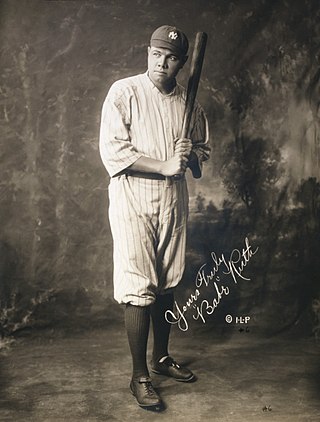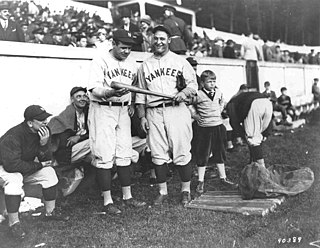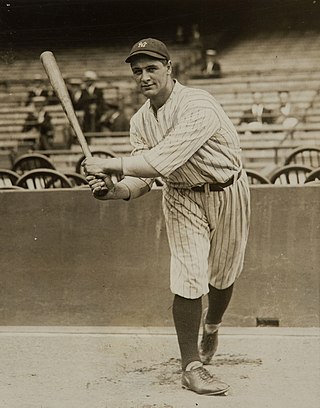
George Herman "Babe" Ruth was an American professional baseball player whose career in Major League Baseball (MLB) spanned 22 seasons, from 1914 through 1935. Nicknamed "the Bambino" and "the Sultan of Swat", he began his MLB career as a star left-handed pitcher for the Boston Red Sox, but achieved his greatest fame as a slugging outfielder for the New York Yankees. Ruth is regarded as one of the greatest sports heroes in American culture and is considered by many to be the greatest baseball player of all time. In 1936, Ruth was elected into the Baseball Hall of Fame as one of its "first five" inaugural members.

The Pride of the Yankees is a 1942 American sports drama film produced by Samuel Goldwyn, directed by Sam Wood, and starring Gary Cooper, Teresa Wright, and Walter Brennan. It is a tribute to the legendary New York Yankees first baseman Lou Gehrig, who died a year before its release, at age 37, from amyotrophic lateral sclerosis, which later became known to the lay public as "Lou Gehrig's disease".

Walter Clement Pipp was an American professional baseball player. A first baseman, Pipp played in Major League Baseball (MLB) for the Detroit Tigers, New York Yankees, and Cincinnati Reds between 1913 and 1928.

Harold Clayton Lloyd, Sr. was an American actor, comedian, and stunt performer who appeared in many silent comedy films.

Murderers' Row were the baseball teams of the New York Yankees in the late 1920s, widely considered some of the best teams in history. The nickname is in particular describing the first six hitters in the 1927 team lineup: Earle Combs, Mark Koenig, Babe Ruth, Lou Gehrig, Bob Meusel, and Tony Lazzeri.

Miller James Huggins was an American professional baseball player and manager. Huggins played second base for the Cincinnati Reds (1904–1909) and St. Louis Cardinals (1910–1916). He managed the Cardinals (1913–1917) and New York Yankees (1918–1929), including the Murderers' Row teams of the 1920s that won six American League (AL) pennants and three World Series championships.

Anthony Michael Lazzeri was an American professional baseball second baseman during the 1920s and 1930s, predominantly with the New York Yankees of Major League Baseball. He was part of the famed "Murderers' Row" Yankee batting lineup of the late 1920s, along with Babe Ruth, Lou Gehrig, and Bob Meusel.

The 1921 World Series was the championship series in Major League Baseball for the 1921 season. The 18th edition of the World Series, it matched the National League champion New York Giants and the American League champion New York Yankees.

The 1923 World Series was the championship series in Major League Baseball for the 1923 season. The 20th edition of the World Series, it matched the American League champion New York Yankees against the National League champion New York Giants. The Yankees beat the Giants in six games. This would be the first of the Yankees' 27 World Series championships. The series was not played in a 2–3–2 format: as with the previous two Series the home field alternated each game, though this time it involved switching ballparks, as the first Yankee Stadium had opened this season.

The 1926 World Series was the championship series of the 1926 Major League Baseball season. The 23rd edition of the Series, it pitted the National League champion St. Louis Cardinals against the American League champion New York Yankees. The Cardinals defeated the Yankees four games to three in the best-of-seven series, which took place from October 2 to 10, 1926, at Yankee Stadium and Sportsman's Park.

The 1927 World Series was the championship series in Major League Baseball for the 1927 season. The 24th edition of the World Series, it matched the American League champion New York Yankees against the National League champion Pittsburgh Pirates. The Yankees won in four games. This was the first sweep of a National League team by an American League team.
The 1928 World Series was the championship series in Major League Baseball for the 1928 season. The 25th edition of the World Series, it matched the American League champion New York Yankees versus the National League champion St. Louis Cardinals. The Yankees beat the Cardinals in four games to win their third championship and become the first team to do back-to-back sweeps.
The 1932 World Series was the championship series in Major League Baseball for the 1932 season. The 29th edition of the World Series, it matched the American League champion New York Yankees versus the National League champions Chicago Cubs. The Yankees won in a four-game sweep. By far it is mostly noteworthy for Babe Ruth's "called shot" home run, in his 10th and last World Series. It was punctuated by fiery arguments between the two teams, heating up the atmosphere before the World Series even began. A record 13 future Hall of Famers played in this World Series, with three other future Hall of Famers also participating: umpire Bill Klem, Yankees manager Joe McCarthy, and Cubs manager Rogers Hornsby. It was also the first World Series in which both teams wore uniforms with numbers on the backs of the shirts.

Robert William Meusel was an American baseball left and right fielder who played in Major League Baseball (MLB) for eleven seasons from 1920 through 1930, all but the last for the New York Yankees. He was best known as a member of the Yankees' championship teams of the 1920s, nicknamed the "Murderers' Row", during which time the team won its first six American League (AL) pennants and first three World Series titles.
Babe Ruth's called shot is the home run hit by Babe Ruth of the New York Yankees against the Chicago Cubs in the fifth inning of Game 3 of the 1932 World Series, held on October 1, 1932, at Wrigley Field in Chicago. During his at-bat, Ruth made a pointing gesture before hitting the home run to deep center field. One of the reporters at the game wrote that Ruth had "called his shot", using terminology from billiards. The episode added to Ruth's superstardom and became a signature event of baseball's golden age.

Benjamin Edwin Paschal was an American baseball outfielder who played eight seasons in Major League Baseball from 1915 to 1929, mostly for the New York Yankees. After two "cup of coffee" stints with the Cleveland Indians in 1915 and the Boston Red Sox in 1920, Paschal spent most of his career as the fourth outfielder and right-handed pinch hitter of the Yankees' Murderers' Row championship teams of the late 1920s. Paschal is best known for hitting .360 in the 1925 season while standing in for Babe Ruth, who missed the first 40 games with a stomach ailment.
The 1935 New York Yankees season was the team's 33rd season. The team finished with a record of 89–60, finishing 3 games behind the Detroit Tigers. New York was managed by Joe McCarthy. The Yankees played at Yankee Stadium.

Edwin Lee Wells, nicknamed "Satchelfoot", was an American baseball pitcher. He played professional baseball for 14 seasons from 1923 to 1936, including 11 seasons in Major League Baseball for the Detroit Tigers (1923–1927), New York Yankees (1929–1932), and St. Louis Browns (1933–1934). Wells was a left-handed pitcher, with a hard fastball and a slow curve. Wells appeared in 291 major league games with a 68–69 record and won a World Series championship with the Yankees in 1932.

Henry Louis Gehrig was an American professional baseball first baseman who played 17 seasons in Major League Baseball (MLB) for the New York Yankees (1923–1939). Gehrig was renowned for his prowess as a hitter and for his durability, which earned him his nickname "the Iron Horse". He is widely regarded as one of the greatest baseball players of all time. He was an All-Star seven consecutive times, a Triple Crown winner once, an American League (AL) Most Valuable Player twice, and a member of six World Series champion teams. He had a career .340 batting average, .632 slugging average, and a .447 on base average. He hit 493 home runs and had 1,995 runs batted in (RBI). He still has the highest ratio of runs scored plus runs batted in per 100 plate appearances (35.08) and per 100 games (156.7) among Hall of Fame players. In 1939, he was elected to the Baseball Hall of Fame and was the first MLB player to have his uniform number (4) retired by a team.
Cecil Rutherford "Rud" Rennie (1897–1956), newspaperman, was a sportswriter for the New York Herald Tribune, chiefly assigned to the New York Yankees baseball team and the New York Giants football team, for some 36 years. He was a friend and confidant of many celebrated sports figures such as Babe Ruth, Lou Gehrig, Joe DiMaggio, Pepper Martin, and Dizzy Dean, as well as his many colleagues in the press box. Much quoted from his writings as well as tossed-off quips, Rennie was a member of The Newspaper Guild from its founding in 1933. He served on the board of directors of the Baseball Writers' Association of America, and was frequently on the yearly selection committee for Most Valuable Player and the Honor Roll, and was on the executive committee of the New York Chapter.
















